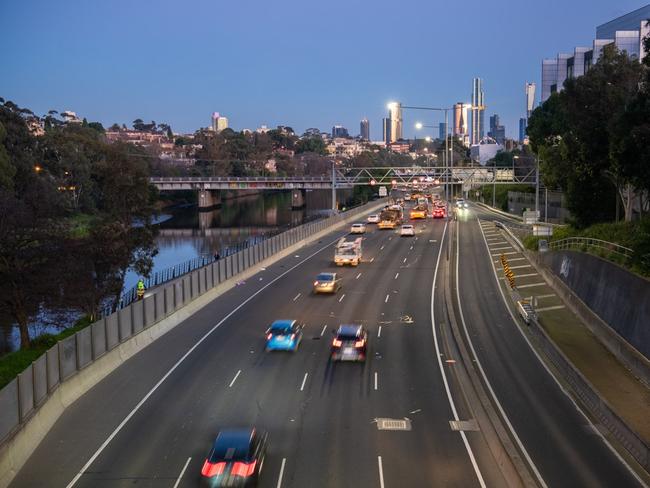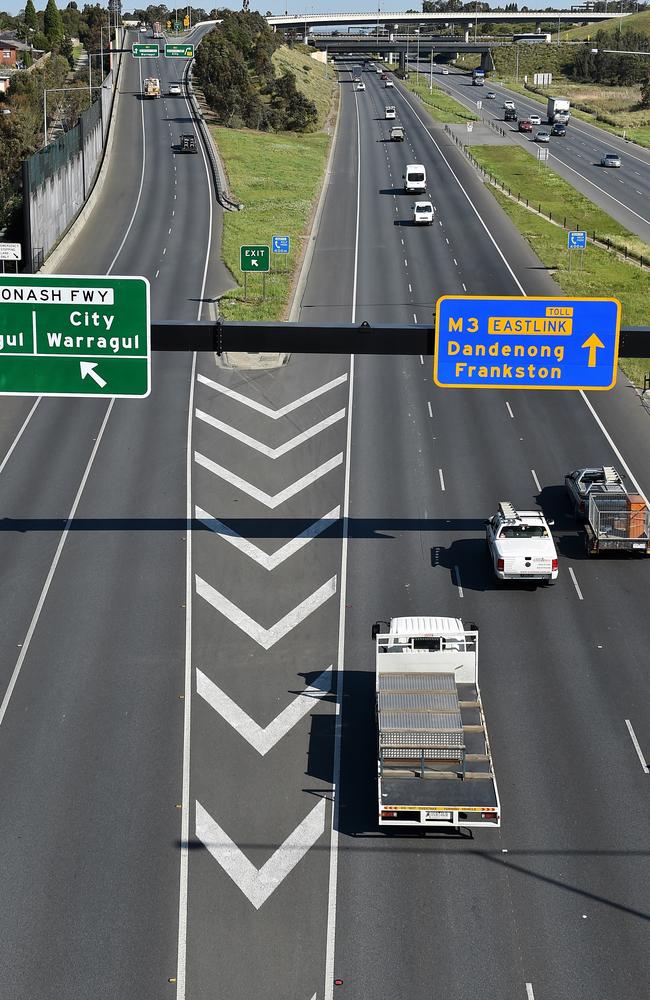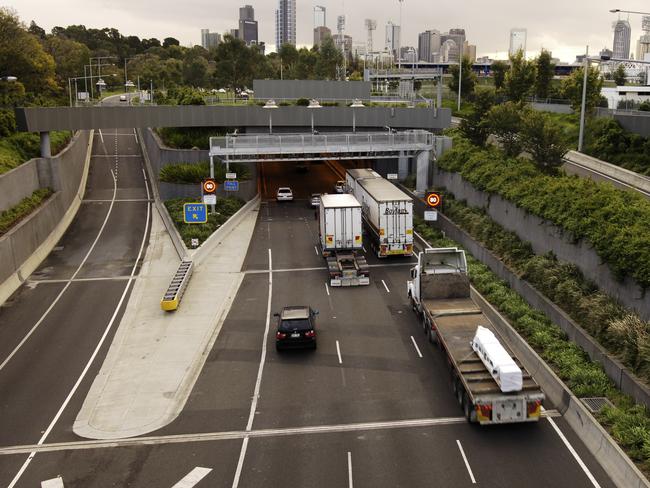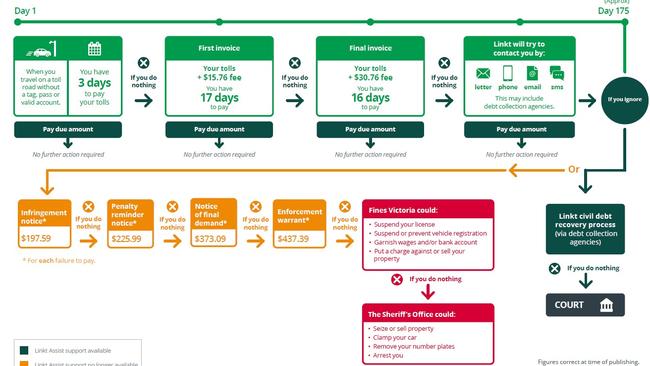How much Victorians pay to travel to Melbourne on EastLink, CityLink toll roads based on where they live
Three things are certain in Melbourne — death, taxes and ever-increasing road tolls. So who pays the most to make it into the CBD? Find out what you pay depending on where you live.
Victoria
Don't miss out on the headlines from Victoria. Followed categories will be added to My News.
Melbourne drivers are forking out up to $32 to drive to and from Melbourne as toll road operators continue to hike their fees to never-before-seen prices.
Predictably, some drivers are being stung more than others, but it may not be who you think, with analysis revealing many of those living closest to the city are copping some of the steepest fees.
Residents in Stonnington, who live just 20-minutes from the city, are paying up to 225 per cent more in tolls than residents coming from the north.
They, along with those from Glen Eira and Monash, are being slugged $10.18 for a one-way trip into Melbourne on tolls roads despite living within 23km of the city.
The 20-minute trip from Stonnginton up the Monash Freeway and into Exhibition St is costing drivers 50c per minute in the car.

In contrast, those living up to three times that distance from the city have a strikingly cheaper commute.
Yarra Ranges residents are being charged $3.49 for a one-way trip on EastLink — that is, if they avoid the Monash at an additional $10.18. Whittlesea residents pay as little as $3.13 to drive in via the Tullamarine Freeway.
Meanwhile, residents living further out in Wyndham and Nillumbik avoid tolls entirely on their fastest route into the city.
Commuters from the Mornington Peninsula and Frankston pay the most of all Victorians to travel into Melbourne at a whopping $16 for a one-way trip.
They cop a double hit — first on the EastLink when they pass through five toll points ($5.82), and then on CityLink between the Monash Freeway / Toorak Rd and Exhibition St / Batman Ave ($10.18).
Transurban said the higher pricing the Monash reflected the “complexity of the original construction”.
Use the map below to find out how much you pay to drive into the city, as well as how much it costs you per minute and kilometre on the road.
Who operates Melbourne’s toll roads?
Victoria has two toll roads – CityLink (operated by Transurban / Linkt) and EastLink (operated by ConnectEast).
The Victorian government allows these companies to charge tolls in return for the upkeep of the roads.
The total cost of a trip on toll roads depends on what type of vehicle you drive, whether you have a tag and how many toll points you pass.
In the 2022-23 financial year, Transurban alone raked in $894m in toll revenue from Melbourne commuters.
Drivers will also be charged to travel on the North East Link once it’s completed in 2028.

How are tolls calculated?
In Brisbane, tolls are escalated annually in line with CPI. In Sydney, tolls are calculated based on considerations of the CPI and average weekly earnings (AWE).
But in Melbourne, Transurban has upped its fees by 4.25 per cent every year since 2019, hikes coming into effect every quarter.
Prices are set to rise about 20 per cent by 2029 from today’s figures, and then Transurban will begin to use CPI to calculate fee increases. Still, even in the case of deflation, Transurban does not plan to lower toll fees.
“Toll prices and how much they rise is set out in our contracts with state or local governments, and are typically a few cents a quarter,” a Transurban spokesperson said.
“On average, around 80 per cent of customers travelling in a private vehicle on CityLink spend less than $10 per week in tolls, all while saving up to 30 minutes on their trips, despite Melbourne’s population growing by 1.3 million people over the past 15 years.”
Transurban offers a trip cap of $11.75 to keep costs “predictable” for longer journeys.

EastLink said it offers the lowest tolls in Australia, and only up its prices in line with CPI once a year.
In fact, travelling the full 39km length of EastLink on a weekday would cost a driver about $4 less than travelling the entire, shorter 22km CityLink.
“EastLink tolls have never increased by more than inflation, as published by ABS,” a spokesperson said.
“This means that EastLink tolls have not changed in real terms since EastLink opened in 2008. EastLink is the only tollway that provides weekend discounts for cars on weekends and public holidays.”
Have tolls always been this expensive?
The toll cap on CityLink has nearly doubled since 2008, rising from $6.21 to $11.75 for drivers in cars, according to figures published in this report.
Costs have risen approximately 30 per cent to travel CityLink since 2017.
But, in good news for Victorians, the ACCC last September refused Transurban’s bid to acquire a majority interest in EastLink, with findings of the investigation concluding the acquisition would “likely substantially lessen competition for future toll road concessions in Victoria” – meaning it could have led to even steeper fees.

Will I get fined if I don’t pay my tolls?
Toll operators slap fees and fines on drivers who fail to pay their way.
Three days after travel, Transurban issues a $15.56 fee on top of a driver’s toll if they have failed to organise a transaction.
Transurban will continue upping the fee and issuing notices. If a driver refuses to pay, they can be issued a $437.39 fine, have their license suspended, face court or even be arrested.

If a motorist travels on EastLink without a valid account or EastLink trip pass, EastLink sends about seven reminders before referring to Victoria Police to issue an infringement notice of $198.
How the figures and map were calculated:
The Herald Sun found the fastest route from each municipality to the Melbourne CBD (330 Lonsdale St) using Google Maps, and then calculated the toll fee through Linkt and EastLink.
A central location within each LGA, as specified by Google Maps, was used to simplify calculations.
The traffic conditions, distance and time estimates were collected on midday, Tuesday October 22.
If the fastest route from a location did not require travelling on a toll road, the cost was recorded as $0.
The figures assume a driver is travelling with a Linkt tag. Without a Linkt tag, costs are dearer.
The figures also assume a commuter is driving a car. Costs vary between vehicle types.
Time of travel and cost per kilometre and minute will differ depending on how far a resident lives from the central location in their LGA.



